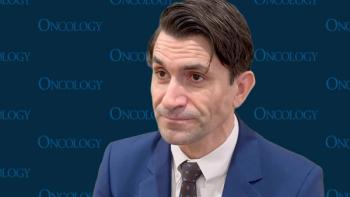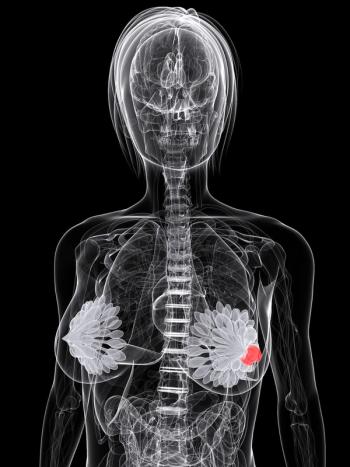
Advanced Melanoma With Resistance to PD-1 Inhibition May Derive Benefit From BO-112 Plus Pembrolizumab
Novel BO-112 when combined with pembrolizumab may offer a new treatment option for patients with advanced melanoma and PD-1 inhibitor therapy resistance.
Advanced melanoma with anti–PD-1 therapy resistance that was treated with BO-112 plus pembrolizumab (Keytruda) demonstrated that the combination could be an efficacious option in this patient group, according to data presented at the
At a median follow-up of 4.1 months (95% CI, 3.9-6.3), findings showed that among patients evaluable for response (n = 40), the combination of BO-112 and pembrolizumab achieved an overall response rate (ORR) of 25%, including a complete response rate of 10% and a partial response rate of 15%. Additionally, 40% had stable disease, and the disease control rate (DCR) was 65%.
“The responses happened in patients including [those with] BRAF-mutated and wild-type melanoma, mucosal histology, and secondary anti–PD-1 resistance. However, patients with acral melanoma or very high lactate dehydrogenase [LDH] have no clinical benefit,” lead study author Iván Márquez-Rodas, MD, PhD, of Hospital General Universitario Gregorio Marañón in Madrid, Spain, said in the presentation.
In patients with advanced melanoma, up to 70% of those who receive anti–PD-1 therapies will experience disease progression, and there is no current standard-of-care therapy in the second line for these patients.2
BO-112 is a synthetic nanoplexed dsRNA designed to activate TLR3, RIG-1, and MDA5. The agent improves antigen presentation through the interferon-independent increase in MHC-I expression, enhances T-cell infiltration, and elicits immunogenic cell death to overcome resistance to anti–PD-1 therapies.
A first-in-human phase 1 trial (NCT02828098) explored BO-112 alone and in combination with a PD-1 inhibitor in adult patients with aggressive solid tumors, including melanoma, where the agent displayed safety and the ability to revert resistance to anti–PD-1 therapies.3
SPOTLIGHT203 enrolled 42 patients who were at least 18 years of age with unresectable stage III or IV cutaneous, acral, or mucosal melanoma and confirmed progressive disease following anti–PD-1 therapy per SITC criteria. Patients were also required to have known BRAF-mutated or BRAF wild-type disease; measurable and injectable disease; only 1 prior line of systemic therapy; and an ECOG performance status of 0 or 1.
Patients were administered BO-112 injections at a dose of up to 2 mg and in up to 8 lesions per cycle once per week for the first 7 weeks, followed by once every 3 weeks, for up to 2 years. Additionally, 200 mg of intravenous pembrolizumab was administered every 3 weeks. Treatment continued until disease progression, unacceptable toxicity, death, withdrawal of consent, or study termination. Notably, BO-112 was also stopped if lesions were no longer injectable.
The study’s primary end point was ORR by RECIST v1.1 per independent radiologist central review. Secondary end points included DCR; duration of response (DOR); progression-free survival (PFS) and overall survival (OS); safety; biomarkers; and radiomics.
The median age of enrolled patients was 65 years (range, 27-88) and 57% were male. Most patients presented with cutaneous melanoma (71%) compared with acral (21%) or mucosal melanoma (7%). Most patients had BRAF wild-type disease (83%) vs BRAF-mutated disease (17%). At baseline, 48% of patients enrolled with M1a-b stage disease (48%), M1c-d stage disease (45%), or unresectable stage III disease (7%). Notably, 41% of patients had high (above the upper limit of normal [ULN]) LDH.
Prior treatment included ipilimumab plus nivolumab (14%); nivolumab alone (33%); pembrolizumab alone (43%); or other anti–PD-1 combinations (10%). The median duration of previous treatment was 30 weeks (range, 6-128), and the prior treatment indication was either adjuvant (24%) or advanced disease (76%). Notably, 62% of patients had primary prior resistance and 38% had secondary prior resistance.
Additional data showed patients with cutaneous melanoma and mucosal melanoma achieved ORRs of 28% and 67%, respectively. Notably, no patients with acral melanoma or an LDH 3 times above the ULN (n = 4) had a response. Additionally, the ORRs were 43% and 21% for patients with BRAF-mutated and BRAF wild-type disease, respectively. Patients with secondary resistance to prior therapy had a 38% ORR compared with 17% for patients with primary prior resistance. Patients with prior treatment in the adjuvant setting (n = 8) or in the advanced setting (n = 32) had ORRs of 13% and 28%, respectively.
Among injected lesions (n = 38), 26% demonstrated a greater than 30% reduction and 53% achieved any reduction. In non-injected lesions (n = 28), 11% had a greater than 30% reduction and 25% experienced any reduction.
The median DOR was not reached (NR; 95% CI, 2 months–NR), and the percentage of patients in response after 6 months was 66.7% (95% CI, 16%-91.4%).
The median PFS in the intention-to-treat population (n = 42) was 3.8 months (95% CI, 3.6-NR). However, in patients with non-acral disease and LDH greater than 3 times the ULN (n = 29), the median PFS was NR (95% CI, 3.8-NR) compared with 2.2 months (95% CI, 0.8-3.6) in patients with acral disease and/or LDH 3 times above the ULN (n = 13).
The median exposure to BO-112 was 3.93 months (95% CI, 3.5-5.8) compared with 3.85 months (95% CI, 3.9-6.3) for pembrolizumab. Notably, treatment was ongoing in 31% of patients at the time of data cutoff.
All 42 patients experienced at least 1 adverse effect (AE) of any grade and 36% encountered a grade 3 or higher AE. Notably, 83% of patients had at least 1 treatment-related AE (TRAE) of any grade; however, 5% experienced a grade 3 or 4 TRAE. Serious AEs occurred in 29% of patients, including serious TRAEs in 7%. Furthermore, 19% of patients discontinued treatment due to AEs, although no patients discontinued treatment due to TRAEs.
The most common grade 1 or 2 TRAEs were asthenia (50%); pyrexia (38%); diarrhea (33%); vomiting (24%); chills (21%); nausea (21%); decreased appetite (14%); headache (14%); injection site pain, discomfort, hematoma, or hypersensitivity (14%); arthralgia (12%); pruritus (12%); influenza-like illness (10%); and back pain (10%).
Based on the findings of SPOTLIGHT203, Márquez-Rodas recommended further research with BO-112 in randomized clinical trials.
References
- Márquez-Rodas I, Dutriaux C, Saiag P, et al. Efficacy of intratumoral BO-112 with systemic pembrolizumab in patients with advanced melanoma refractory to anti-PD-1-based therapy: final results of SPOTLIGHT-203 phase 2 study. Presented at. 2022 AACR Annual Meeting; April 8-13, 2022; New Orleans, LA. Abstract CT014.
- Wolchok JD, Chiarion-Sileni V, Gonzalez R, et al. Long-term outcomes with nivolumab plus ipilimumab or nivolumab alone versus ipilimumab in patients with advanced melanoma. J Clin Oncol. 2022;40(2):127-137. doi:10.1200/JCO.21.02229
- Márquez-Rodas I, Longo F, Rodriguez-Ruiz ME, et al. Intratumoral nanoplexed poly I:C BO-112 in combination with systemic anti-PD-1 for patients with anti-PD-1-refractory tumors. Sci Transl Med. 2020;12(565):eabb0391. doi:10.1126/scitranslmed.abb0391
Newsletter
Stay up to date on recent advances in the multidisciplinary approach to cancer.
















































































